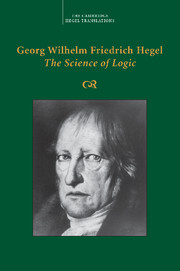Chapter 3 - The Absolute Relation
Published online by Cambridge University Press: 30 September 2021
Summary
Absolute necessity is not so much the necessary, even less a necessary, but necessity – being simply as reflection. It is relation because it is a distinguishing whosemoments are themselves the whole totality of necessity, and therefore subsist absolutely, but do so in such a way that their subsisting is one subsistence, and the difference only the reflective shine of themovement of exposition, and this reflective shine is the absolute itself. – Essence as such is reflection or a shining; as absolute relation, however, essence is the reflective shine posited as reflective shine, one which, as such self-referring, is absolute actuality. – The absolute, first expounded by external reflection, as absolute form or as necessity now expounds itself; this self-exposition is its self-positing, and is only this self-positing. – Just as the light of nature is not a something, nor is it a thing, but its being is rather only its shining, so manifestation is self-identical absolute actuality.
The sides of the absolute relation are not, therefore, attributes. In the attribute the absolute reflectively shines only in one of its moments, as in a presupposition that external reflection has simply assumed. But the expositor of the absolute is the absolute necessity which, as self-determining, is identical with itself. Since this necessity is the reflective shining posited as reflective shining, the sides of this relation, because they are as shine, are totalities; for as shine, the differences are themselves and their opposite, that is, they are the whole; and, conversely, they thus are only shine because they are totalities. Thus this distinguishing, this reflecting shining of the absolute, is only the identical positing of itself.
This relation in its immediate concept is the relation of substance and accidents, the immediate internal disappearing and becoming of the absolute reflective shine. If substance determines itself as a being-for-itself over against an other or is absolute relation as something real, then we have the relation of causality. Finally, when this last relation passes over into reciprocal causality by referring itself to itself, we then have the absolute relation also posited in accordance with the determination it contains; this posited unity of itself in its determinations, which are posited as the whole itself and consequently equally as determinations, is then the concept.
- Type
- Chapter
- Information
- Georg Wilhelm Friedrich Hegel: The Science of Logic , pp. 489 - 506Publisher: Cambridge University PressPrint publication year: 2010



